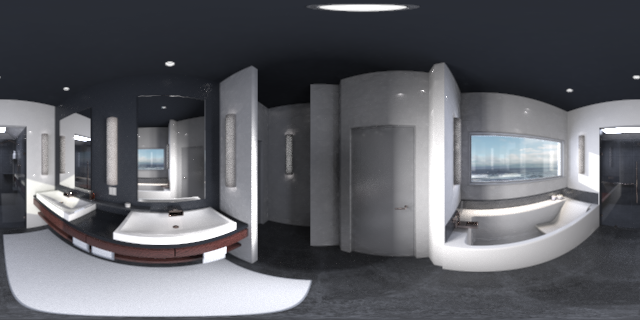On this page
The VR capabilities in KeyShot allow you to use VR devices, such as the Oculus Rift and the HTC Vive, to view KeyShot scenes. There are two applications for using VR with KeyShot:
- Render VR Images
View rendered panoramic images rendered in KeyShot. This mode is compatible with any type of VR device capable of viewing VR images. Please check with the manufacturer of the device to know what type of image is necessary. Learn more - Work in Real-time VR
View and render the Real-time View through the VR headset. This mode is only compatible with the Oculus Rift and OpenVR compatible headsets, such as the HTC Vive, Valve Index, and Windows Mixed Reality headsets. Learn more
Accessing KeyShot VR Settings
VR capabilities are a KeyShot Pro feature. (Compare KeyShot versions.) All VR settings are accessed from the Project window, Camera tab, under the Lens Settings and Stereo sections.
Terminology
Cube Map
- In this mode, six views will be rendered side by side.
- The views are: Front, Back, Right, Left, Top, Bottom.
- If your device supports stereo cube maps it will automatically orient the images for you to view them correctly.

Spherical
- As described by the name, this image will look like a flattened out sphere.
- This mode will be compatible with most devices out there.

Side-by-side
- In order to see the image in 3D via the headset, you need to have the same image played in both eyes. In this mode both images are stitched next to each other.

Over-under
- In order for you to see the image in 3D in the headset, you need to have the same image played in both eyes. In this mode both images are stitched one on top of the other.
Eye Distance
- This is to set the distance between your eyes. This is a setting that you configured when setting up your head-mounted display. Use the same distance set when setting up your device.
Pole Merging Angle
- This is a parameter for stereo rendering. It is the angle at which pole merging begins. It helps avoid artifacts when looking upward and downward. The eye distance value is kept the same until the viewing angle reaches the specified angle after which the eye distance is gradually decreased until it reaches a value of 0 when looking directly downwards or upwards.